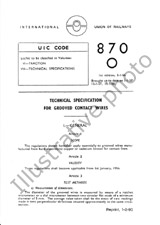We need your consent to use the individual data so that you can see information about your interests, among other things. Click "OK" to give your consent.

UIC 541-08-4ed.
Brakes - Regulations concerning the manufacture of the different brake parts - Derailment detectors for wagons
STANDARD published on 1.6.2007
The information about the standard:
Designation standards: UIC 541-08-4ed.
Publication date standards: 1.6.2007
SKU: NS-550228
The number of pages: 13
Approximate weight : 39 g (0.09 lbs)
Country: International technical standard
Category: Technical standards UIC
Annotation of standard text UIC 541-08-4ed. :
Summary:
ry The purpose of a derailment detector is to stop the train by activating automatic application of the brakes or to send a signal to the train driver when its triggering threshold has been reached following a wagon derailment. The derailment detector cannot prevent derailments. Its presence on a vehicule should never be used as an excuse for cutting back or compromising on preventive vehicule maintenance. The pneumatic derailment detector monitors vertical accelerations at wagon-body level and, when its triggering threshold is reached, opens a large aperture to exhaust the main brake pipe to atmosphere. The electronic derailment detector does not necessarily cause the main brake pipe of the vehicle concerned to open. If the train is equipped with a train control-command and diagnosis system, the detector can transmit an advance warning and derailment signal to the driver. (The relevant conditions have not yet been defined in this leaflet). Accelerations occurring in normal service should not trigger the derailment detector. It is crucial that, in the event of a derailment, the vertical acceleration occurring at the point where the derailment detector is to be fitted exceeds the triggering threshold of the detector. This applies irrespective of the load conditions and speed of the wagon. The derailment detector should be designed to operate on lines that meet the quality standards laid down in UIC Leaflet 518, Appendix D (QN1-QN3).
Name:Bremse - Vorschriften für den Bau der verschiedenen Bremsteile - Entgleisungsdetektoren für Güterwagen| Zusammenfassung Die Aufgabe des Entgleisungsdetektors besteht darin, bei Erreichen seiner Ansprechschwelle infolge der Entgleisungen von Güterwagen durch Auslösen einer Zwangsbremsung den Zug anzuhalten, respektive eine Meldung an den Triebfahrzeugführer abzusetzen. Der Entgleisungsdetektor kann keine Entgleisungen verhindern. Seine Existenz am Fahrzeug darf niemals dazu Anlass sein, beim Präventivunterhalt der Fahrzeuge Abstriche zu machen oder Kompromisse einzugehen. Der pneumatisch wirkende Entgleisungsdetektor kontrolliert die Vertikalbeschleunigungen am Wagenkasten des Güterwagens und öffnet, wenn sein Ansprechwert erreicht ist, die Hauptluftleitung über einen großen Querschnitt. Der elektronisch arbeitende Entgleisungsdetektor bewirkt nicht zwangsläufig das öffnen der Hauptluftleitung am betroffenen Fahrzeug. Bei Vorhandensein einer zugüberdeckenden Leit- und Diagnosetechnik kann eine Vorwarn- und Entgleisungsmeldung an den Führerstand abgesetzt werden. (Die hierfür geltenden Bedingungen sind in diesem Merkblatt noch nicht definiert). Im normalen Betrieb auftretende Beschleunigungen dürfen nicht zum Ansprechen des Entgleisungsdetektors führen. Es muss gewährleistet sein, dass die Vertikalbeschleunigung an der Stelle, an der der Entgleisungsdetektor angebaut werden soll, im Falle einer Entgleisung die Ansprechgrenze des Detektors sicher überschreitet. Dies gilt für jeden Ladezustand und für jede Geschwindigkeit des Wagens. Die Funktion des Entgleisungsdetektors muss auf Gleisen gemäß UIC-Merkblatt Nr. 518, Anlage 2 (QN1-QN3) gewährleistet sein.
We recommend:
Updating of laws
Do you want to be sure about the validity of used regulations?
We offer you a solution so that you could use valid and updated legislative regulations.
Would you like to get more information? Look at this page.



 Cookies
Cookies
